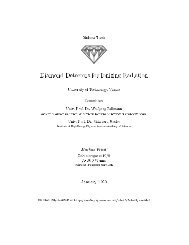You also want an ePaper? Increase the reach of your titles
YUMPU automatically turns print PDFs into web optimized ePapers that Google loves.
luminosity) and limited storage bandwidth (only about 100 full events/second), CMSalso requires an extraordinarily powerful trigger and Data Acquisition (DAQ) systemto select interesting events.3.2.2 Coordinate SystemThe coordinate system used CMS is centered at the nominal interaction point, withthe y axis pointing straight up and the x axis pointing at the center of the LHCarc. This leaves the z axis pointing in the direction of the clockwise LHC beam.Since the detector has an approximate cylinder symmetry, it is also useful to definean azimuthal angle ϕ in the x/y plane with the x axis at ϕ = 0. The correspondingpolar angle θ is measured from the positive z axis. Instead of θ, the pseudorapidityη = − ln(tan(θ/2)) is usually used. As the name suggests, it is a good approximationfor the relativistic rapidity ξ = 1 2 ln( E+p ZE−p Z) in the z direction. This can be seen bysubstituting p z = |p| sin(θ) and performing some trigonometric substitutions in η toarrive atη = 1 2 ln(|p| + p Z) (3.1)|p| − p ZIf the momentum is large or the mass is small, E ≈ p obtains and the approximationholds. This allows one to approximately keep the useful properties of rapidity(such as invariance of rapidity differences under Lorentz boosts) while having a generalcoordinate (independent on the mass of the particle under consideration) that iscomparatively simple to calculate.3.2.3 Inner TrackerThe inner tracker is the innermost component of the CMS detector, surrounding theinteraction point in a cylindrical volume that is 5.8 m long and and has a diameter of2.6 m. The CMS solenoid provides a homogeneous 4 T magnetic field in this region.The tracker is designed to measure the tracks of charged particles to very high precisionand allow identification of secondary interaction vertices. To identify such verticesfrom b and τ decays requires a spatial resolution of 10 − 20 µm. At LHC designluminosity, the tracker will be traversed by about 1000 charged particles per bunchcrossing. To combat occupancy effects in this scenario requires high granularity, sothat the innermost layers of the tracker consist of silicon pixel detectors. Since theparticle flux per unit area through the outer layers is much lower, these can be builtout of silicon microstrips. High granularity and fast readout requirements combine tocause significant power dissipation from the on-detector electronics, which needs to beremoved by an efficient cooling mechanism. Furthermore, it is desirable to minimizethe amount of material in this part of the detector to avoid unwanted interactions.The Pixel DetectorThe pixel detector consists of the innermost three layers in the barrel tracker (atmean radii of 4.4 cm, 7.3 cm and 10.2 cm) and the innermost two layers of the tracker21












